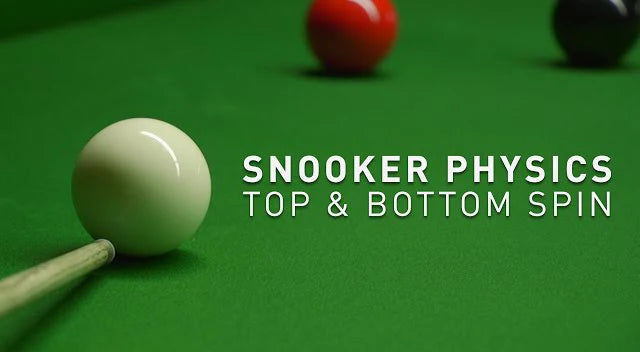
The Role of Spin in Snooker: How to Master Topspin, Backspin, and Sidespin
There’s something quietly magical about watching a cue ball obey your command—spinning, curving, pulling back, and dancing across the green baize like it knows where you want it to be. In snooker, spin isn't just a technique; it's the heart of the game.
Whether you’re chasing a century break or simply trying not to snooker yourself, understanding how spin works—and how to use it is what separates casual potters from truly strategic players. In this guide, we’ll explain the mysteries of topspin, backspin, and sidespin in easy-to-understand terms, helping you improve your skills and control over the cue ball.
Why Spin Matters: It’s All in the Cue Ball
Think of the cue ball as your dance partner. You lead, and it follows. But unless you learn the right moves, it'll only step on your toes. Every great snooker player knows that the real game happens after the pot. Where the cue ball lands determines everything.
Spin is the key to hitting the ball where you want it. Spin allows you to:
- Control the cue ball’s direction after contact
- Set up your next shot with precision
- Get out of tight spots or awkward angles
- Make the game feel less like guesswork and more like geometry
And mastering spin doesn’t require superhuman strength—it requires knowledge, practice, and the right billiard snooker cue in your hands.
Topspin: Moving Forward with Purpose
Topspin (also called follow-through) is what you get when you strike the cue ball just above center. This adds forward rotation, so after hitting the object ball, the cue ball continues to roll forward, sometimes even accelerating.
It’s ideal when:
- You want to follow through to the next shot
- You’re setting up a shot and need forward momentum
- You’re trying to control angles off cushions
Topspin is like pushing a pram gently downhill—it keeps rolling naturally, even after the push.
Quick tip: Strike the cue ball smoothly and maintain a steady follow-through. Sharp movements reduce the spin effect.
Backspin: Pulling Back Like A Pro
Backspin (or screw) occurs when you hit the cue ball below its centre, causing it to spin backwards. This makes it draw back toward you after striking the object ball.
This action is useful in the following situations:
- You need to return the cue ball to stay on the black
- You’re recovering from a poor position
- You want to keep things tidy and close for your next shot
Think of backspin like a yo-yo—it goes out, makes contact, and then bounces back gracefully.
Pro insight: A clean, sharp strike and a well-conditioned cue tip are essential. If you’re using a poor-quality cue stick or a worn tip, it just won’t bite. (That’s why serious players invest in handmade pool cues with proper balance and response.)
Sidespin: English with a Twist
Now let's look at the tricks. Sidespin, or “English,” is when you hit the cue ball off-centre, left or right. This causes the cue ball to deflect slightly before and especially after contact with the pool table.
Use the sidespin can:
- Change the angles of the cushions
- Avoid awkward ball clusters
- Pull off clever positional shots when straight lines don’t cut it
It's a bit like parallel parking on a busy street—you have to judge the angle and curve correctly. Get it wrong, and you'll hit the bumper. Get it right, and your opponent might just sit back and applaud.
Warning: Overusing sidespin without understanding how it affects deflection (also known as “squirt”) can lead to mistakes or even missed shots altogether. Practice it purposefully.
It’s All Physics—But Don’t Let It Scare You
Snooker spin is pure physics. Friction, force, angle, velocity—all rolled into one gentle strike. But you don’t need to wear a lab coat to understand it.
Here are the key points:
- Hitting the ball higher = topspin
- Hitting the ball lower = backspin
- Hitting the ball to the side = sidespin
- Combine various elements to create a refined shot
The secret isn't power, but timing, precision, and technique—and a billiard cue that responds the way you expect it to. At Mark Richard, we craft cues that feel like extensions of your hand, giving you complete control over spin, speed, and accuracy.
Practice with Purpose
You wouldn’t trust a mechanic who never picked up a spanner. The same is true in snooker. You have to practice, repeat, fail, and then keep adjusting.
Try this:
- Set up a simple pot with the cue ball straight behind a red ball
- Practice applying topspin, then backspin, then left and right sidespin
- Observe what happens after contact, not just whether the ball goes in
The more you repeat these controlled experiments, the more muscle memory you build—and soon, you’ll find that spin isn't just a technique, it's second nature.
Advanced Shots: The Sign of a True Player
Once you've mastered the basics, you can start combining various types of spin. Add a touch of topside with left spin. Try a soft screw with slight right spin. These mixed shots let you move the cue ball like a snooker sat-nav—redirecting its course with pinpoint accuracy.
Not sure? Watch the greats. Players like Ronnie O'Sullivan and Neil Robertson apply spin frame by frame, like chess players moving pieces, always thinking three steps ahead.
Spin Is the Soul of the Game
In the end, learning spin in snooker is like learning a language. Once you’re fluent, the table opens up. You're no longer reactive; you're in control. You anticipate possibilities and dictate the tempo of the match, rather than letting your opponent dictate it.
So, whether you're upgrading your first cue or looking to finally understand what that "clicky" sound off the cushion means, take the time to master the language of spin.
Because once you do, you're no longer just playing the game—you’re composing it.
